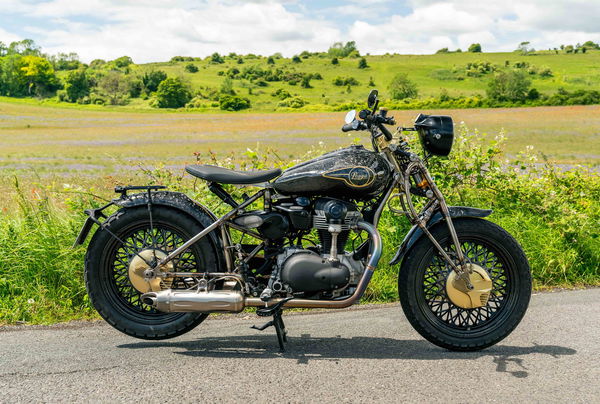KTM 990 Duke Review: A Huge Improvement, With A Few Catches
The 990 Duke represents a big step forward from the 890 it replaces, but the improvements come at a cost

KTM’s resurrected 790 Duke came along a little too soon. It was launched last year to a fair bit of confusion - what was the point in a 790 Duke when we had the 890 Duke? Sure, it was cheaper partly by virtue of its Chinese manufacture, but not by a whole lot. By EICMA 2023, though, it all made sense, as the Austrian company had something up its sleeve to usurp the 890 Duke - the KTM 990 Duke.
Suddenly, the range makes a lot more sense. The 790 Duke serves as the affordable entry point, with the 990 proving a bigger step up than the 890 in terms of its engine, technology and — yes — price. We’ll get to all of that stuff soon.
The 990 Duke slots neatly between the 790 Duke and the bonkers (and also new) 1390 Super Duke R and Super Duke R Evo. So is it the sweet spot, or a compromise best overlooked in favour of either its cheaper or more expensive siblings? To find out, we rode a 990 Duke for several hundred miles in the UK, taking in motorways, dual carriageways, twisty country roads and urban environments.
Price and availability
Here’s the bit that might sting a little - whereas the old 890 Duke was £10,699, the new 990 Duke starts at £12,999. That doesn’t include the tech pack, which you definitely want, which costs £887 and adds various features which will otherwise disappear once a 930-mile trial period is up.
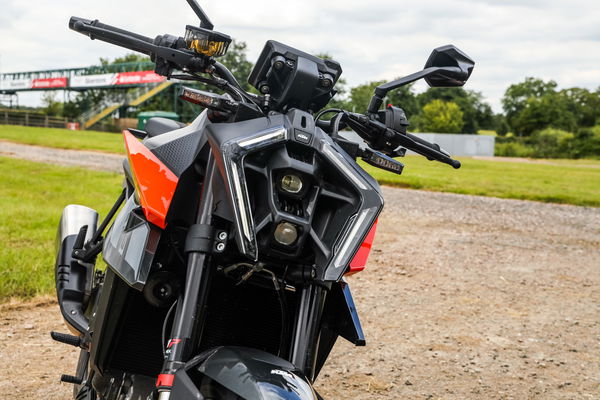
That said, this being KTM, which loves a discount as much as big-chain supermarkets, there is (at the time of writing) a deal which will let you spec it for free, and also enjoy zero per cent finance. Then again, the brand is also lopping £1,000 off 2023 model year Duke GPs and Duke Rs, meaning — if you can find stock — you can pick up one of those for £9,669 or £10,599 respectively.
What’s different about the KTM 990 Duke?
You’re probably now wondering where the extra cash goes, other than some new stickers that say ‘990’ instead of ‘890’, but worry not, as plenty has changed. Let’s start with the reason for that new model name - the updated LC8c parallel twin engine.
Displacement is up from 889cc to 946cc, and inside, the familiar-looking casings are new pistons, fresh conrods, a new crankshaft and higher-lift cams. The capacity increase is down to both a lengthened stroke and bigger cylinder bores. There’s also a bigger radiator to keep all of this cool, plus a new exhaust and airbox.
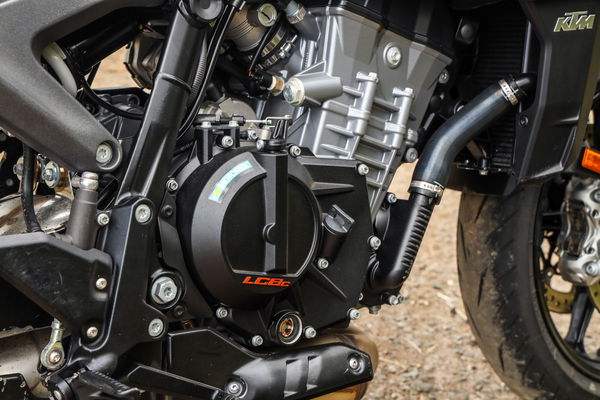
The result of all this is an increase of…7bhp. You might wonder why KTM bothered, but the new peak power/torque figures of 121bhp and 76lb ft only tell part of the story. The riding experience tells another. More on that soon.
The engine sits in a new tubular steel frame, from which KTM has hung suspension provided by in-house brand WP. This is where the 990 starts to look more like a Duke R than a Duke GP, as the fork is fully adjustable, just as it was on the former model. It provides 140mm of travel from 43mm wide stanchions. At the rear meanwhile is a WP Apex monoshock with adjustable preload and rebound.
Like the old Duke GP, you get twin 300mm front discs and four-piston, own-brand calipers, but there’s a new mounting setup which shaves 500g of rotational mass. There’s a 240mm disc and a two-piston caliper up back, meanwhile.m floating discs are paired with 4 piston radially mounted calipers controlled by a radial master cylinder up And yes, that frame is now clothed in opinion-dividing bodywork. KTM says the bike “is designed to resemble an explosion in a freeze-frame, mimicking immense energy being released with devastating force,” but all I see is Predator with his mask off. It’s certainly not dull, tying in nicely with KTM’s aggressive “no bullshit” marketing schtick.

The tech front is another area of significant change. The five-inch TFT display has new graphics and a redesigned menu structure while providing lean angle data and an optional Track mode with telemetry and a lap timer. It now features a handy USB-C charge port to the left.
There’s a healthy supply of rider aids, including adjustable wheelie control, an up-and-down quickshifter, cornering ABS (with a supermoto mode to disengage it at the rear), cornering traction control and launch control.
What’s it like to ride?
It’s amazing just how unfamiliar the new 990 feels. Although the figures sound near enough the same, it’s a whole different ballgame when you’re behind the bars winding out the throttle. For one thing, it seems smoother and more refined, particularly in the mid-range.
That’s not to say the 990 has grown up, bought some beige jumpers and started watching Countdown. Quite the opposite - the updated unit has merely cemented KTM’s position as the builders of motorcycling’s most aggressive parallel twin.

As before, it uses a 285-degree crankshaft for an offset firing order, unlike its cross-plane rivals like Yamaha’s CP2 which create the same effect with a 270-degree crank. It’s about as far away from the sort of sewing machine-like 180-degree parallel twin in the bike you might have done your direct access on, with a rumbly mid-range and a howling top end.
At full tilt, it feels quicker than the figures seem to suggest - pull off an overtake on a dawdling Honda Jazz, and you might find your speed is a bit higher than anticipated at the other end. You might also find yourself unexpectedly popping the front wheel up a touch. But hey - the own-brand brakes are plenty effective enough at scrubbing off speed when necessary, although the initial response from the lever is a touch sharp.
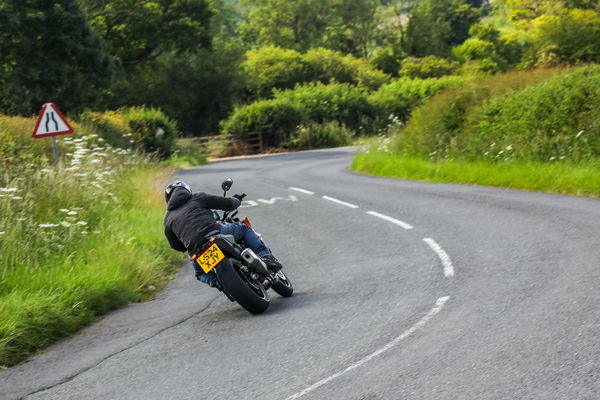
The smooth mid-range clout means you can get away with leaving the 990 in a higher gear than you otherwise might, but doing so means missing out on not just the exciting top end, but also the shifter. It seems a slicker system than before, shifting beautifully every single time, and without a single false neutral cropping up during our week and a half with the bike.
It’s more than just a straight-line missile, though. It’s an agile bike, helped by the fact it weighs a pithy 190kg with fuel - we rode the 990 back to back with the new 1390 Super Duke R and the difference in mass is immediately obvious when swapping bikes.
The lighter 990 laps up fast changes in direction, yet in the faster corners it feels more stable than the old 890 Duke. Meanwhile, the Bridgestone S22 tyres give plenty of confidence when at more extreme angles of lean, which, of course, are now displayed for you to see, but you will need to be in the Track Mode display to see max lean angles. Otherwise, you only get realtime data which you ought not to be looking at too closely while concentrating on cornering.
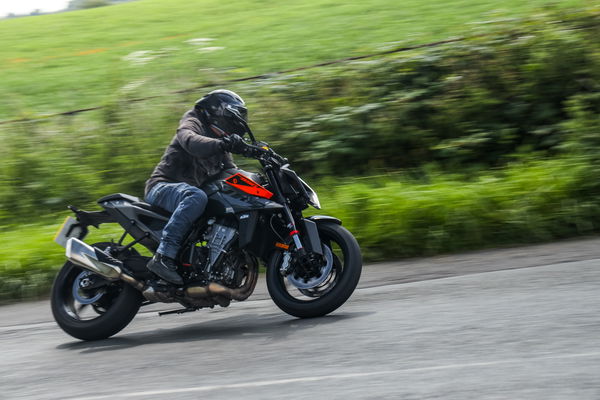
The updated electronics suite on the whole, though, is a triumph. It flatters the rider more than it did before, without feeling like the gizmos are taking too much away. Interventions are sympathetic, and there’s so much adjustability in the various settings that you’re sure to find a level of assistance that’s right for you.
What you might also need to fiddle with, though, is the suspension adjusters. As supplied, the damping felt overly firm for our two, reasonably light test riders, and although dialling things back with the adjusters (compression and rebound at the front is easily changed with hand-operated adjusters, but you’ll need a flathead screwdriver for compression tweaks at the rear), the setup didn’t feel quite as plush as hoped.

It’s something that robbed a little confidence on bumpier B-roads (and let’s face it, there are lots of those these days) in what is otherwise a supremely capable package. Another annoyance concerns the throttle, which can be jerky at low speeds in all modes (Street, Sport and Track).
Should you buy a KTM 990 Duke?
Such is the big step forward the 990 Duke represents, we’d definitely recommend 890 owners go for a test ride. And if you’re undecided between a 990 or a 1390 Superduke R, we’d steer you towards the former - it’s so much more useable on the road, yet still feels plenty ferocious and at times a little excessive, in a way a Triumph Street Triple RS doesn’t quite emulate. It also feels like a much more serious bike than the 790 Duke.
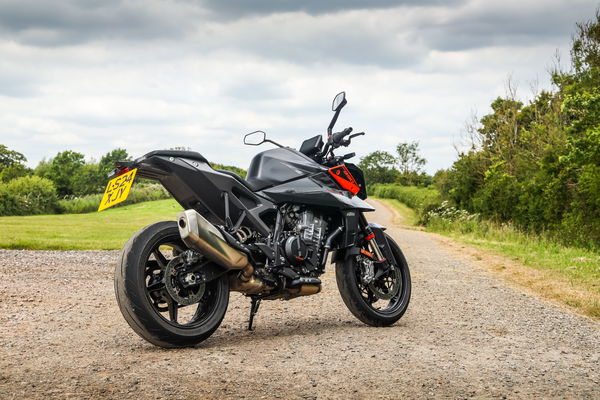
The 990 is more expensive than the Triumph, though, and a lot pricier than the excellent new Yamaha MT-09 and MT-09 SP, despite feeling cheaper built than all of those. Without the Tech Pack offer, adding it on pitches the 990 uncomfortably close to the Ducati Streetfighter V2, a bike with less divisive looks, more brand kudos and an even more powerful engine that’s a joy to use at any level of throttle input, partly due to its characterful, bassy exhaust note.
The KTM, on the other hand, doesn’t reveal its true character until you’re really gunning it, at which point you’re going rather fast. But then again, that seems true to KTM’s ethos. The 990 Duke is a hooligan that eggs you on from the moment you thumb the starter button. So you can forgive it for being a bit expensive, a little too firm and quite Marmite in the looks department, because it’s never, ever boring.
